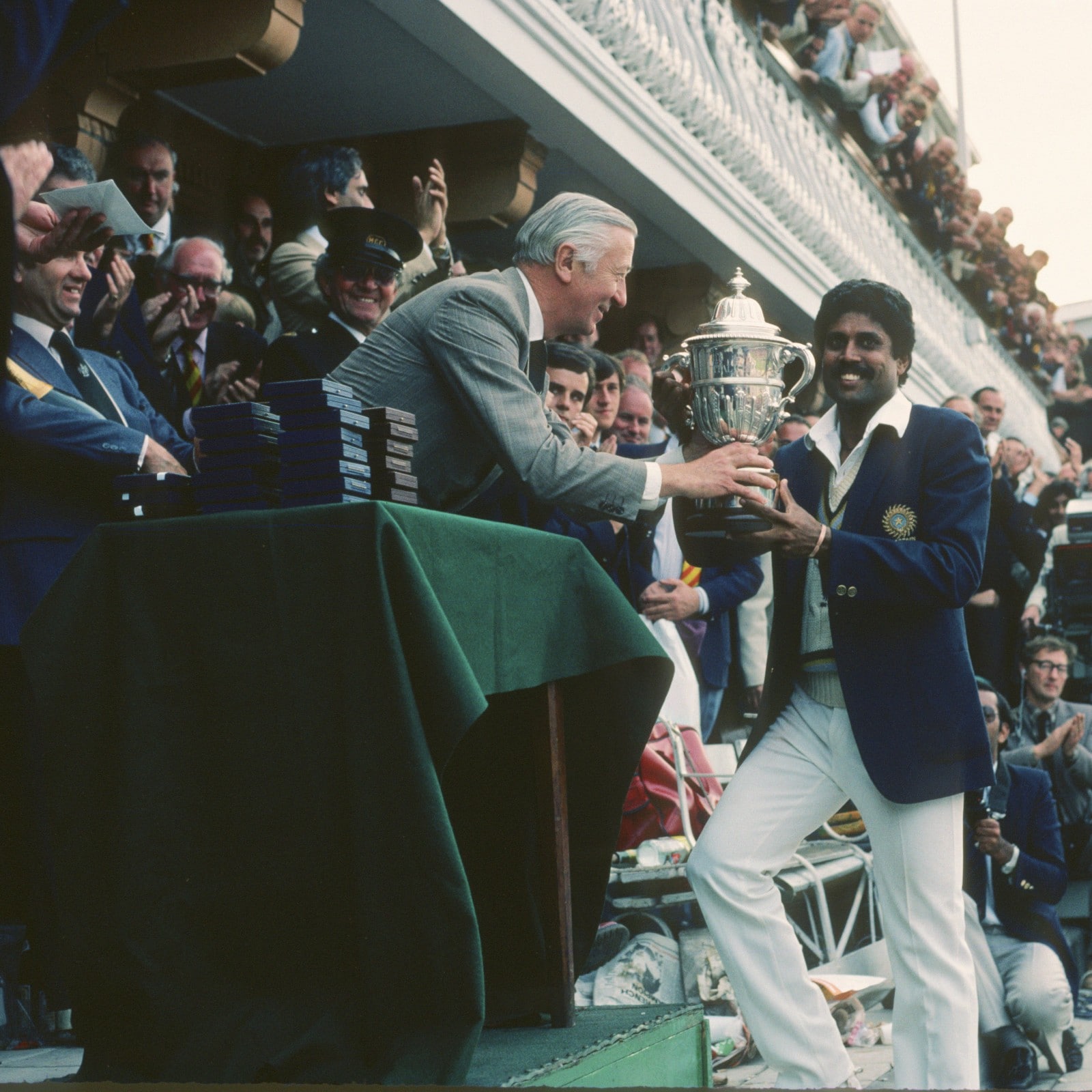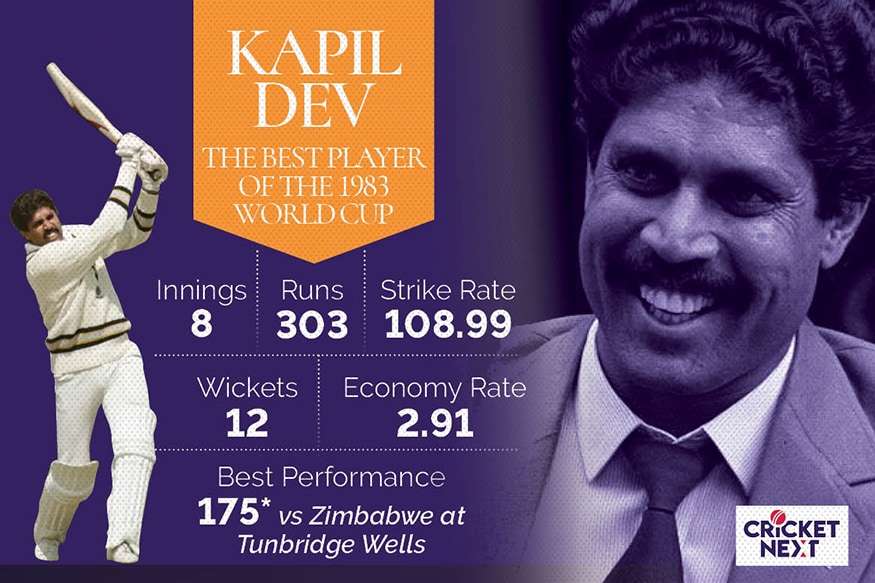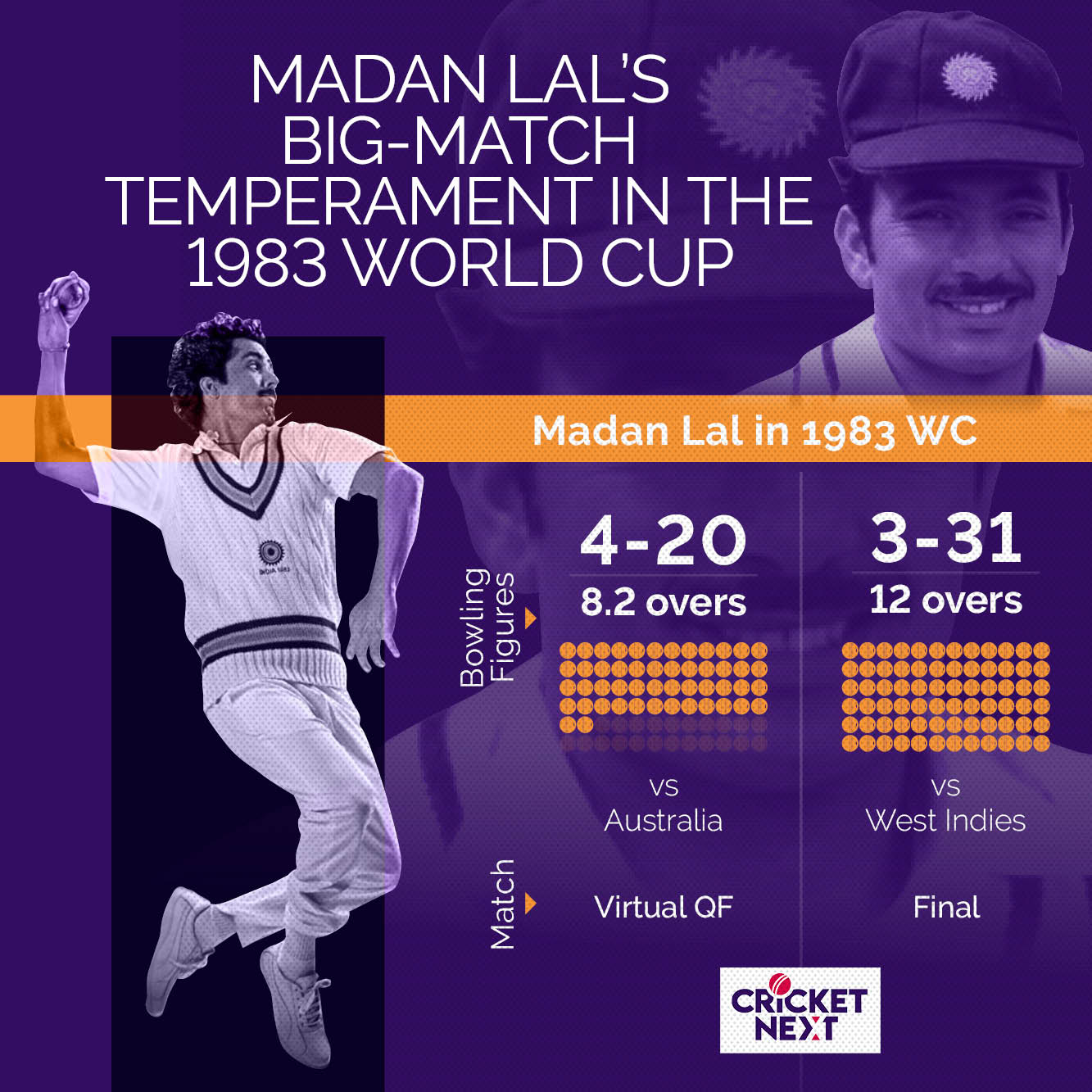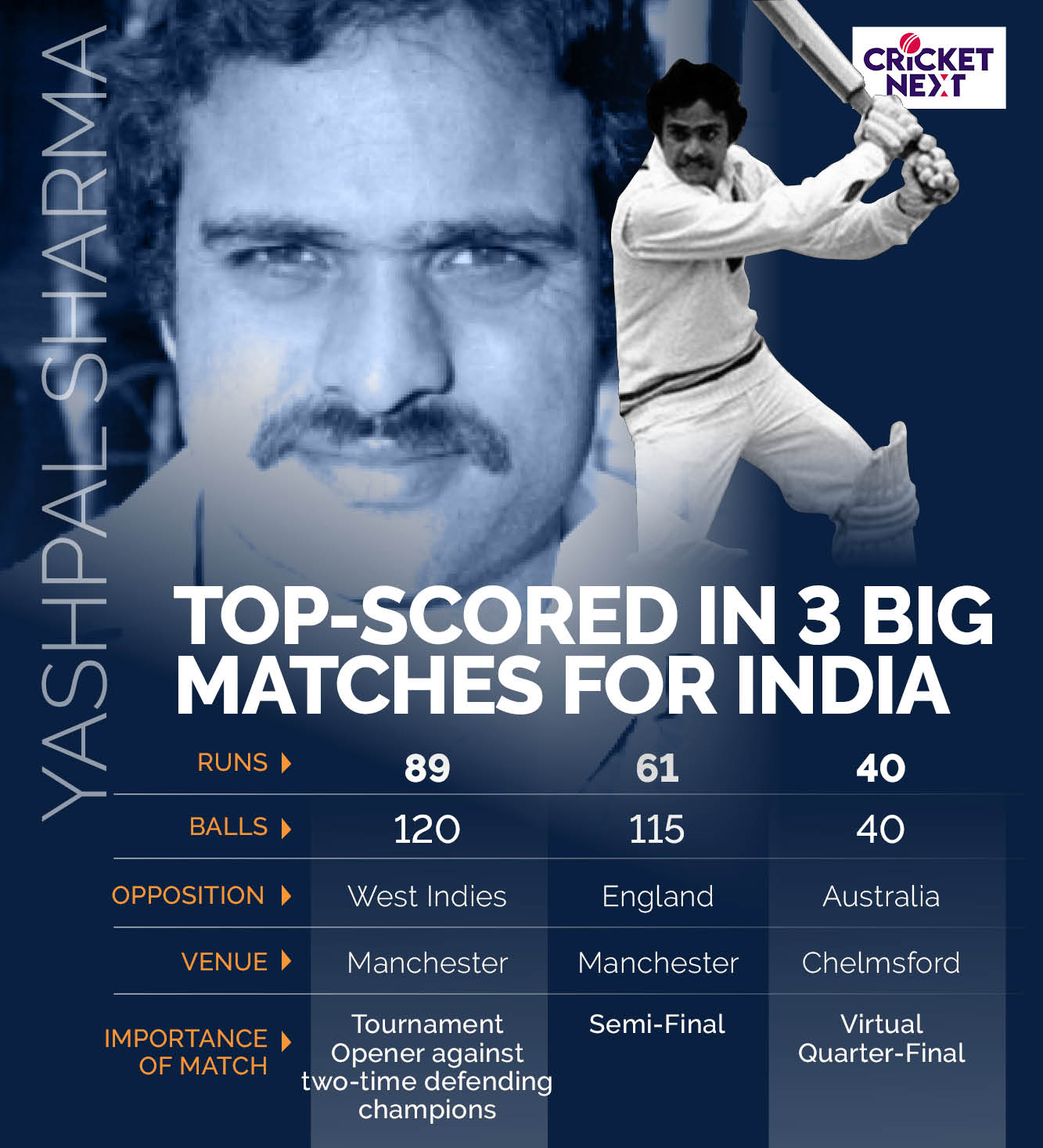1983 World Cup victory anniversary: The 1983 World Cup not only changed the way cricket was viewed and played in India but it changed India itself. 39 years ago, on this very day, when Kapil Dev lifted the coveted trophy at the iconic Lord’s balcony, it inspired and brought together a nation of 750 million, and continues to do so.
We look at 8 insights on the players standing and performances in India’s winning journey in the tournament.
Kapil Dev – Most Influential Player of the Tournament
Kapil Dev’s unbeaten 175 off just 138 balls (from 9 for 4 which was soon reduced to 17 for 5 against Zimbabwe at Tunbridge Wells) was the second most impressive batting performance in India’s ODI history (with Rohit Sharma’s world-class debut). Record 264 onwards). He absorbed the pressure of wickets falling around him, revived the innings and still ended up scoring at a pace much above the standard of the match.
In pictures: 1983 Cricket World Cup Victory Anniversary: Reel vs Real Life Meet Kapil’s Devils
Kapil made 126 pairs with Syed Kirmani – 9. second largest partnership forth Wickets in ODI history He scored 65.78% of the total runs scored by India in the match – the second highest number of runs scored by an individual batsman in ODI history after Viv Richards’ 189 (out of 272 in West Indies in Manchester in 1984). is the ratio.

His batting performance was so disastrous that his performance with the ball was completely forgotten in the match – Kapil was the most restrictive bowler of the match conceding just 32 runs in his 11 overs – his efforts to keep Zimbabwe’s batsmen under control. Took a long way. And that ultimately resulted in a crucial 31-run victory for India.
It was a quality that defined Kapil’s performance with the ball throughout the tournament – his ability to deliver tight spells and high economy impact – basically giving away runs at a rate below the standard of the match. Defending 183 runs against West Indies in the final, he bowled 4 maidens and gave a tough fight to the batsmen conceding just 21 runs in his 11 overs.
He was India’s most economical bowler and had an economy rate of less than 3 in four out of 8 matches in the tournament. His economy rate of 2.91 in the tournament was well below the average rate of 3.74 for all fast bowlers.
As a player, Kapil did not fail even once in the 8 matches he played in the tournament. He was the fifth-highest run-scorer and scored at a strike rate of 108.99 – the second-highest of the World Cup after Rod Marsh (minimum 100 runs). He also took 12 wickets.
This was accompanied by his agility on the field – running back to take a Viv Richards catch – perhaps the most defining moment in India’s cricket history! Add to the mix his inspiring leadership that led India to a historic victory and Kapil Dev was the leading all-rounder of the tournament.
Sandeep Patil – Most Influential Indian Batsman of the Tournament
Despite being ranked 16th in the run tally and being the fourth-highest run-scorer for India, it is Sandeep Patil who emerged as the Indian batsman with the highest impact of the 1983 World Cup – an overall and comprehensive, according to the Impact Index. Cricket analytical system that measures the contribution of a player relative to the contribution of other players to the match in the context of each performance.
Three qualities defined Patil’s performance in the World Cup – 1) he made useful contributions, often coming to bat under pressure when the team had lost early wickets, 2) he scored well above the standard of the match. scored runs and 3) he raised his game in the big matches – the knockouts – giving his best when it matters most.
Patil’s strike rate of 90 in the tournament was several notches above the average standard of 66.36 (over 200 runs). He had the audacity to counter attack the most feared opposition bowlers like Roberts, Marshall, Garner, Holding, Willis and Botham to name a few.
He came up with a defining performance in the semi-final against England – 51 off 32 deliveries and supporting work in the virtual quarter-finals against Australia (30 off 25 deliveries) and in the final against West Indies (27 off 29 deliveries).
Madan Lal – Bowler of the Tournament
Lal was going without a wicket just once in 8 matches in the tournament and 11 of his 17 wickets were from top opposition batsmen (in the 1-5 position). Like Patil, he raised his game in big matches – knockouts. He returned with a 4-20 in 8.2 overs in a do-or-die match against Australia at Chelmsford, but his performance in the final was stellar. Against the race of the game and with West Indies running away with the match, he got rid of Haynes and then claimed the prize wicket of Viv Richards seven runs later, dramatically changing the fate of the match. He soon broke the backbone of the West Indian middle order seeing Gomes’s back. Speed changed. India had the upper hand. the rest is history.
Madan Lal finished as the player with the second highest impact of the tournament.
Mohinder Amarnath – 3rd Most Influential Player of the Tournament
The man of the match in the semi-finals and final actually turned out to be the third highest impact player of the tournament behind Kapil Dev and Madan Lal.
Amarnath made two stellar all-round performances in the two biggest matches of the tournament. In the semi-finals in Manchester, he got the crucial wickets of Gower – the World Cup’s highest run-scorer, and Gatting chased down the target with 46 off 92 balls for just 27 runs in his 12 overs. At Lord’s, he scored a patient 26 and then returned with the ball to end a potentially dangerous 43-run stand for 7.th Dujon’s wicket-taker. He received Marshall immediately before claiming Holding’s final wicket to lead India to a memorable victory.
But Amarnath also failed with the bat in 4 out of 8 matches in the tournament – this diminished his overall impact and was put behind Kapil and Lal. Not surprisingly, his bowling impact was just 3% less than his batting impact in the tournament.
Yashpal Sharma – 3 big performances in 3 big matches
Yashpal Sharma scored the most runs in 3 big matches in the tournament for India. He scored a 120-ball 89 in their opener against the West Indies at Old Trafford, which was instrumental as India made a major upset by defeating the two-time World Cup winners – a victory that gave the side confidence and helped them stay ahead of the rest. inspired to. Tournament.
He then scored a 40-run-a-ball 40 against Australia in the virtual quarter-final at Chelmsford and a 115-ball 61 against England in the semi-final, curtailing his natural attacking game, playing according to the situation.
This exemplary big-match in the biggest tournament in his country’s cricket history was Prabhav Sharma’s legacy of Indian cricket.
Roger Binny – Best opposition wicket-taker in a row
Roger Binny was the leading wicket-taker of the World Cup, taking 18 wickets in 8 matches at an average of 18.66. The quality of his dismissal was unparalleled. 14 of his 18 wickets were from top-middle-order (1-6) opposition batsmen, including the wickets of Lloyd (twice), Richards and Border.
He was exceptionally consistent and took at least one wicket in all the 8 matches he played in the tournament.
Binny gave two outstanding performances – 3-48 against the West Indies in the opener which included the wickets of Richards and Lloyd and 4-29 against Australia at Chelmsford in which he ran through his top-order by looking at the backs of Wood, Hook and Yalop. took. Their pursuit in succession ended completely.
Total team effort from India
There were some great individual performances but India’s historic victory could not have been possible without the effort of the entire team – that was the journey of the 1983 World Cup.
According to the Impact Index, 11 out of 13 Indian players who played the tournament had an impact greater than 1 and 6 of them had an impact greater than 2 – this basically means that 6 Indian players did more than 2 players. And 5 of them did at least the equivalent of one player – this kind of team effort is rare and exceptional!
Interestingly, the only two players who punched well under their weight and made an impact of less than 1 were the two great batting stars – Gavaskar and Vengsarkar. The latter played just 2 matches but Gavaskar had a forgettable tournament in which he scored just 59 runs in the 6 matches he played.
Srikanth top score and his similarity with Gambhir
Gautam Gambhir scored the most runs for India in two major tournament finals – against Pakistan in the WT20 final in Johannesburg in 2007 and against Sri Lanka in the 2011 World Cup final in Mumbai.
While most cricket pundits remember Gambhir’s unique record, another Indian batsman achieved the feat only a few decades back.
Kris Srikkanth, with 38, was the top scorer for India in the final of the 1983 World Cup at Lord’s. Interestingly, he was also the highest scorer for India in the final of the 1985 Benson & Hedges World Championship of Cricket against Pakistan at the MCG. Thus, Srikanth, like Gambhir, top-scored for India in the final in their two biggest wins in history.
Get all the latest updates cricket news, cricket pictures, cricket videos And cricket score Here



